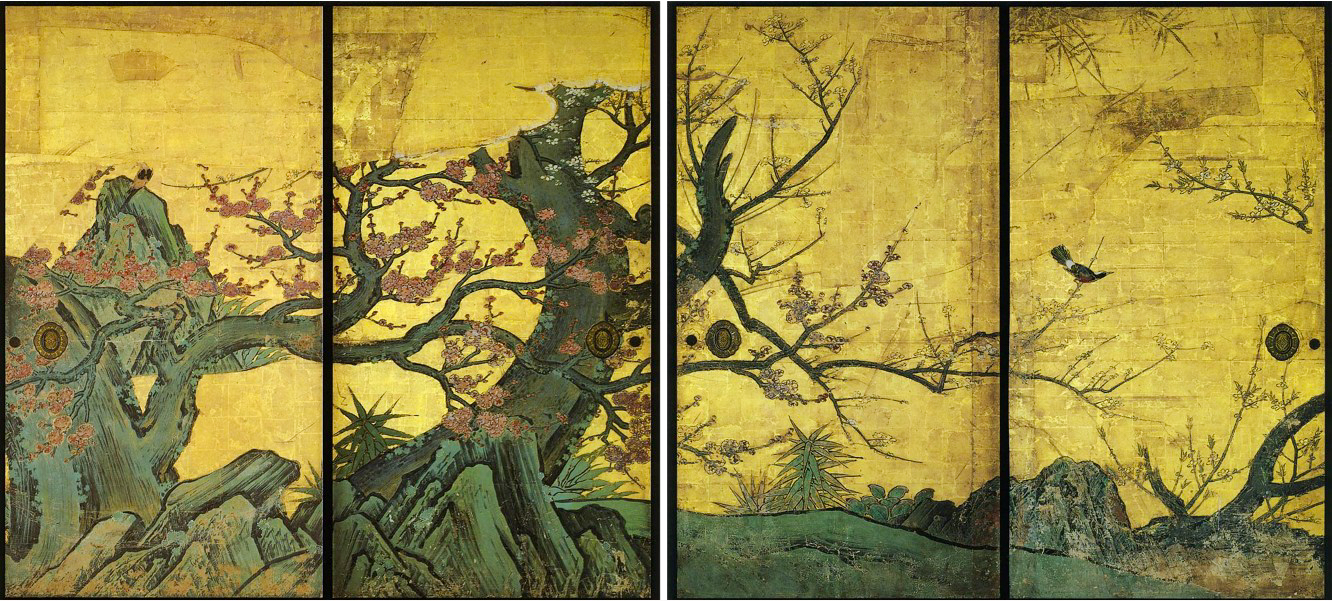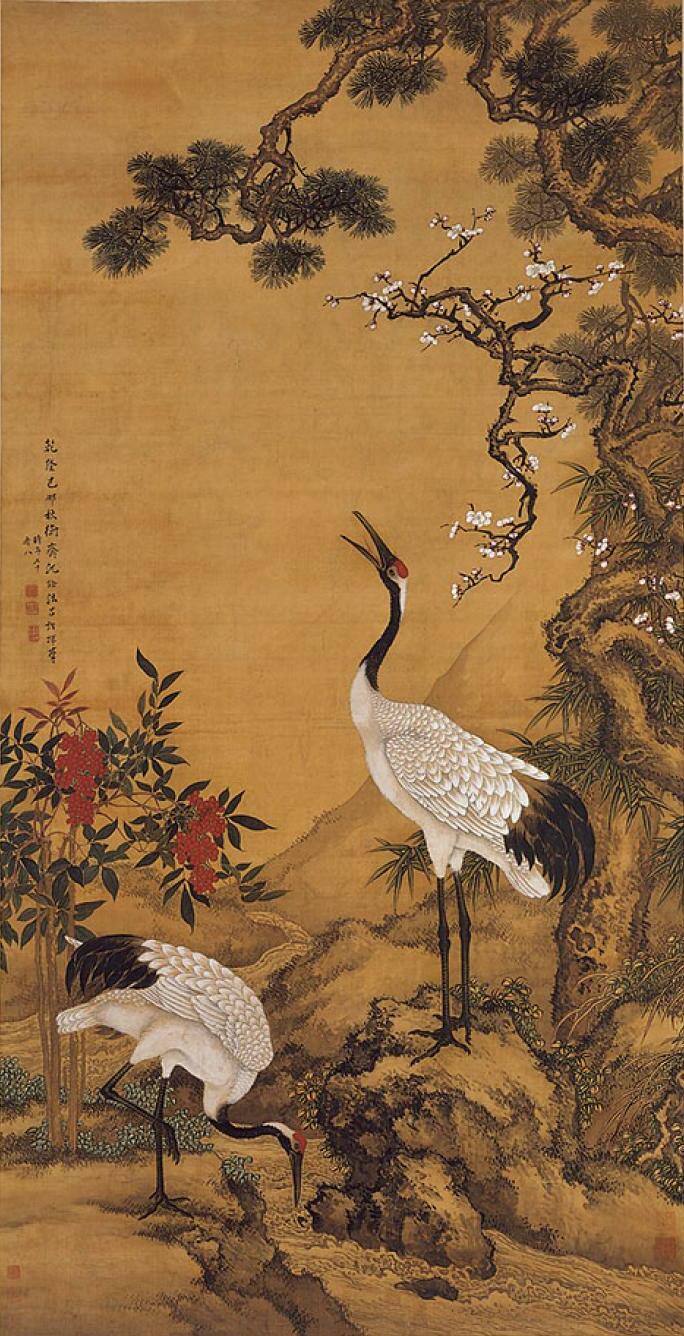|
Shen Quan
Shen Quan (; c. 1682–1760) was a Chinese painter during the Qing dynasty (1644–1912). His courtesy name was Nanpin (南蘋) and his sobriquet was Hengzhai (衡斎). His works became influential in Japanese Edo period art. Biography Shen was born in Deqing in Zhejiang province. He specialized in bird-and-flower painting, and was influenced by Bian Jingzhao and Lü Ji. His works were painted in a very realistic style, and he had many students and patrons. Shen was invited to Japan by a high official. He arrived in Nagasaki in the final month of 1731 with two students, acquiring many Japanese students after his arrival. His paintings soon became very popular, and after his 1733 return to China he continued to send paintings back to Japan. Shen had many pupils while in Japan; his most important was Kumashiro Yūhi, who in turn taught Sō Shiseki and Kakutei. Other artists influenced by Shen included Katsushika Hokusai, Maruyama Ōkyo, and Ganku. Shen's paintings were ... [...More Info...] [...Related Items...] OR: [Wikipedia] [Google] [Baidu] |
Shen (surname)
__NOTOC__ Shen may refer to: * Shen (Chinese religion) (神), a central word in Chinese philosophy, religion, and traditional Chinese medicine; term for god or spirit * Shen (clam-monster) (蜃), a shapeshifting Chinese dragon believed to create mirages * Shenendehowa Central School District, abbreviated as Shen * Shen ring, an Ancient Egyptian hieroglyphic symbol, a form of cartouche Surnames * Shěn (surname), the most common Chinese surname Shen (沈) * Shēn (surname), Chinese surname Shen (申) * Shèn (surname), Chinese surname Shen (慎) Places * Shen, an ancient place in Israel/Palestine (mentioned in ) * Shen County (莘县), in Shandong, China * State of Shen, (申国) Chinese vassal state during the Zhou dynasty * Shen (申) or Shēnchéng (申城, City of Shen), an alternate name of Shanghai * Shenyang (沈阳), a city in Liaoning, China Entertainment * Shen (character), a character in Ender's Game * Shén, a fictional race from the world of Tékumel * Shen, a characte ... [...More Info...] [...Related Items...] OR: [Wikipedia] [Google] [Baidu] |
Katsushika Hokusai
, known simply as Hokusai, was a Japanese ukiyo-e artist of the Edo period, active as a painter and printmaker. He is best known for the woodblock print series '' Thirty-Six Views of Mount Fuji'', which includes the iconic print ''The Great Wave off Kanagawa''. Hokusai was instrumental in developing ''ukiyo-e'' from a style of portraiture largely focused on courtesans and actors into a much broader style of art that focused on landscapes, plants, and animals. Hokusai created the monumental ''Thirty-Six Views of Mount Fuji'' as a response to a domestic travel boom in Japan and as part of a personal interest in Mount Fuji. It was this series, specifically, ''The Great Wave off Kanagawa'' and ''Fine Wind, Clear Morning'', that secured his fame both in Japan and overseas. Hokusai was best known for his woodblock ukiyo-e prints, but he worked in a variety of mediums including painting and book illustration. Starting as a young child, he continued working and improving his style u ... [...More Info...] [...Related Items...] OR: [Wikipedia] [Google] [Baidu] |
Painters From Zhejiang
Painting is the practice of applying paint, pigment, color or other medium to a solid surface (called the "matrix" or "support"). The medium is commonly applied to the base with a brush, but other implements, such as knives, sponges, and airbrushes, can be used. In art, the term ''painting ''describes both the act and the result of the action (the final work is called "a painting"). The support for paintings includes such surfaces as walls, paper, canvas, wood, glass, lacquer, pottery, leaf, copper and concrete, and the painting may incorporate multiple other materials, including sand, clay, paper, plaster, gold leaf, and even whole objects. Painting is an important form in the visual arts, bringing in elements such as drawing, composition, gesture (as in gestural painting), narration (as in narrative art), and abstraction (as in abstract art). Paintings can be naturalistic and representational (as in still life and landscape painting), photographic, abstract, nar ... [...More Info...] [...Related Items...] OR: [Wikipedia] [Google] [Baidu] |
1760 Deaths
Year 176 ( CLXXVI) was a leap year starting on Sunday (link will display the full calendar) of the Julian calendar. At the time, it was known as the Year of the Consulship of Proculus and Aper (or, less frequently, year 929 ''Ab urbe condita''). The denomination 176 for this year has been used since the early medieval period, when the Anno Domini calendar era became the prevalent method in Europe for naming years. Events By place Roman Empire * November 27 – Emperor Marcus Aurelius grants his son Commodus the rank of ''Imperator'', and makes him Supreme Commander of the Roman legions. * December 23 – Marcus Aurelius and Commodus enter Rome after a campaign north of the Alps, and receive a triumph for their victories over the Germanic tribes. * The Equestrian Statue of Marcus Aurelius is made. It is now kept at Museo Capitolini in Rome (approximate date). Births * Fa Zheng, Chinese nobleman and adviser (d. 220) * Liu Bian, Chinese emperor of the Han Dynasty ( ... [...More Info...] [...Related Items...] OR: [Wikipedia] [Google] [Baidu] |
1682 Births
Year 168 ( CLXVIII) was a leap year starting on Thursday (link will display the full calendar) of the Julian calendar. At the time, it was known as the Year of the Consulship of Apronianus and Paullus (or, less frequently, year 921 ''Ab urbe condita''). The denomination 168 for this year has been used since the early medieval period, when the Anno Domini calendar era became the prevalent method in Europe for naming years. Events By place Roman Empire * Emperor Marcus Aurelius and his adopted brother Lucius Verus leave Rome, and establish their headquarters at Aquileia. * The Roman army crosses the Alps into Pannonia, and subdues the Marcomanni at Carnuntum, north of the Danube. Asia * Emperor Ling of Han succeeds Emperor Huan of Han as the emperor of the Chinese Han Dynasty; the first year of the ''Jianning'' era. Births * Cao Ren, Chinese general (d. 223) * Gu Yong, Chinese chancellor (d. 243) * Li Tong, Chinese general (d. 209) Deaths * Anicetus, pope of Rom ... [...More Info...] [...Related Items...] OR: [Wikipedia] [Google] [Baidu] |
Japanese Painting
is one of the oldest and most highly refined of the Japanese visual arts, encompassing a wide variety of genres and styles. As with the history of Japanese arts in general, the long history of Japanese painting exhibits synthesis and competition between native Japanese aesthetics and the adaptation of imported ideas, mainly from Chinese painting, which was especially influential at a number of points; significant Western influence only comes from the 19th century onwards, beginning at the same time as Japanese art was influencing that of the West. Areas of subject matter where Chinese influence has been repeatedly significant include Buddhist religious painting, ink-wash painting of landscapes in the Chinese literati painting tradition, calligraphy of sinograms, and the painting of animals and plants, especially birds and flowers. However, distinctively Japanese traditions have developed in all these fields. The subject matter that is widely regarded as most characteristic o ... [...More Info...] [...Related Items...] OR: [Wikipedia] [Google] [Baidu] |
Chinese Painting
Chinese painting () is one of the oldest continuous artistic traditions in the world. Painting in the traditional style is known today in Chinese as ''guó huà'' (), meaning "national painting" or "native painting", as opposed to Western styles of art which became popular in China in the 20th century. It is also called ''danqing'' (). Traditional painting involves essentially the same techniques as calligraphy and is done with a brush dipped in black ink or coloured pigments; oils are not used. As with calligraphy, the most popular materials on which paintings are made are paper and silk. The finished work can be mounted on scrolls, such as hanging scrolls or handscrolls. Traditional painting can also be done on album sheets, walls, lacquerware, folding screens, and other media. The two main techniques in Chinese painting are: * Gongbi (工筆), meaning "meticulous", uses highly detailed brushstrokes that delimit details very precisely. It is often highly colored and usual ... [...More Info...] [...Related Items...] OR: [Wikipedia] [Google] [Baidu] |
Bird-and-flower Painting
Bird-and-flower painting, called () in Chinese, is a kind of Chinese painting with a long tradition in China and is considered one of the treasures of Chinese culture. The was named after its subject matter. It originated in the Tang dynasty where it gained popularity, matured at the of the Tang dynasty and during the Five Dynasties and Ten Kingdoms period, and fully reached its peak during the Song dynasty where it clearly became socially relevant in Chinese culture. Normally, most paintings belong to the scholar-artist style of Chinese painting. The became prevalent in East Asia, where it was introduced in Japan during the 14th century and was introduced in Korea. Intended purpose and cultural significance According to Chinese tradition, the covers "flowers, birds, fish, and insects" (); thus, it can deal with a wide range of natural topics, including flowers, fish, insects, birds, pets (dogs, cats), etc. The paintings are inspired by the resilience and the beauty of t ... [...More Info...] [...Related Items...] OR: [Wikipedia] [Google] [Baidu] |
Nanpin School
The Nanpin school (南蘋派 ''Nanpin-ha'') was a school of painting which flourished in Nagasaki during the Edo period. Etymology The school takes its name from Nanpin, the art name of Chinese painter Shen Quan (1682–1760), an artist who painted in the Ming academic style. History Shen Quan arrived in Nagasaki on the 37th ship on December 3, 1731, and left Japan two years later, on September 18, 1733. He specialised in bird-and-flower painting (Ch: ''huaniao hua'', J: ''kachōga''), one of the major artistic subjects, especially among professional Chinese painters. The commercial activity in the port of Nagasaki facilitated the spread of Western knowledge in Japan. Japanese people were also particularly interested in ancient Chinese culture. Paintings of the Nanpin school show flora and fauna that are not just "realistic", but styled as they appear in Chinese and European treatises. In the 18th century, Japanese people became very interested in Western natural sciences ... [...More Info...] [...Related Items...] OR: [Wikipedia] [Google] [Baidu] |
Shen Nanpi Pair Of Hares And Plum Blossom In The Snow
__NOTOC__ Shen may refer to: * Shen (Chinese religion) (神), a central word in Chinese philosophy, religion, and traditional Chinese medicine; term for god or spirit * Shen (clam-monster) (蜃), a shapeshifting Chinese dragon believed to create mirages * Shenendehowa Central School District, abbreviated as Shen * Shen ring, an Ancient Egyptian hieroglyphic symbol, a form of cartouche Surnames * Shěn (surname), the most common Chinese surname Shen (沈) * Shēn (surname), Chinese surname Shen (申) * Shèn (surname), Chinese surname Shen (慎) Places * Shen, an ancient place in Israel/Palestine (mentioned in ) * Shen County (莘县), in Shandong, China * State of Shen, (申国) Chinese vassal state during the Zhou dynasty * Shen (申) or Shēnchéng (申城, City of Shen), an alternate name of Shanghai * Shenyang (沈阳), a city in Liaoning, China Entertainment * Shen (character), a character in Ender's Game * Shén, a fictional race from the world of Tékumel * Shen, a ch ... [...More Info...] [...Related Items...] OR: [Wikipedia] [Google] [Baidu] |





